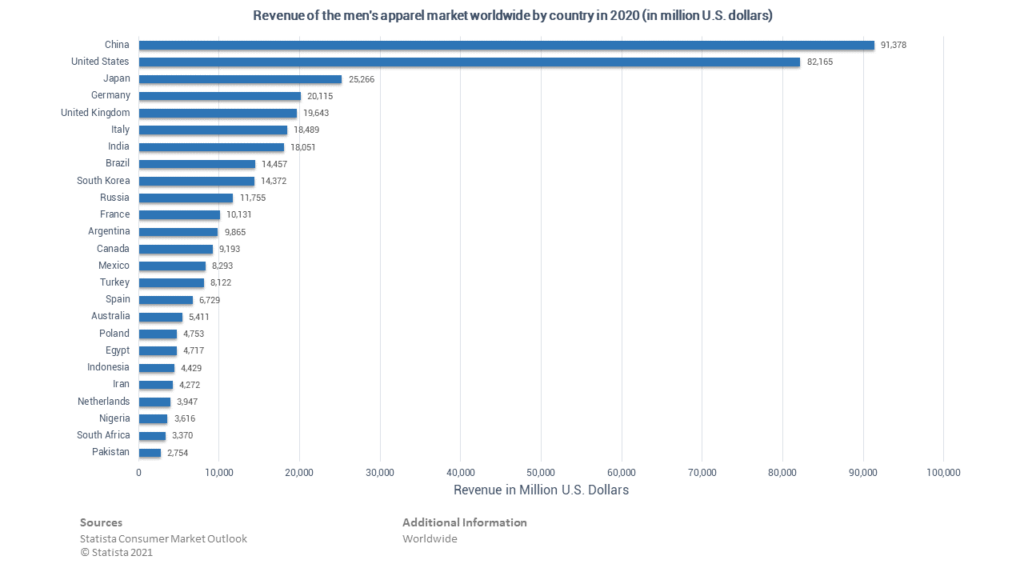According to Statista Market Outlook, the men’s clothing market includes all types of clothes for boys and men. Except for the babies’ clothes, children’s clothes still fall into the definition. Even though the women’s apparel market is the largest, the men’s clothing market is about half as big as it is. Men’s clothes are divided into the following segments: coats and outdoor jackets, jackets, blazers and suits, trousers, shirts, pullovers, and underwear for men.
Even though women have the biggest spending power in fashion, the men’s market growth leads the race across all the fashion segments, including luxury goods. Well, according to an article from the Vogue magazine, sales of high-end menswear grew faster than womenswear for three consecutive years leading up to 2018. Furthermore, many legendary brands that were solely focused on women’s clothing, are now diving into the men’s clothing segments and launching their collections, such as Stella McCartney and Isabel Marant.
Leading the worldwide men’s clothing market revenue in 2020, China makes rapid progress and surpassed the United States as the largest men’s clothing market, along with Japan, Germany, and the United Kingdom in the top 5 list. The convenience offered by online shopping not to mention the increasing range of products on offer is the key factor encouraging men to shop for apparel. The United States fashion e-Commerce market is expected to increase from USD 60.2 billion U in 2016 to almost USD 100 billion in 2021. The e-tailer is led by Macy’s and followed by Amazon, Gap, and Nordstrom in this space.
Regardless of the COVID-19 crisis, the global market for men’s clothing was estimated at USD 451.2 million in the year 2020 and is projected to reach a revised size of USD 552.4 million by 2027, growing at a CAGR of 2.9% over the analysis period 2020 – 2027.
Coats and Jackets are projected to record a 3.2% CAGR and reach USD 61.4 million by the end of the analysis period. After an early analysis of the business implications of the pandemic and its induced economic crisis, growth in the Jackets, Blazers & Suits segment is readjusted to a 2.2% CAGR for the next 7-year period.
Post-COVID-19 Shopping Behavior
Consumers are heading back to the physical stores as the lockdown restrictions were lifted in many parts of the world, resulting in what’s called revenge shopping, a post-COVID-19 shopping behavior. Thereupon, the fashion market returned to the pre-pandemic stage, making the worldwide men’s clothing market revenue rapidly growing.
The world’s apparel retail market is expected to enjoy a 7.5% growth in 2021 – 2022 to USD 1.84 billion in 2022 and a 6.1% growth in 2022 – 2023 to USD 1.95 billion dollars in 2023 according to the newest industry reports.
Top 10 Countries with the Biggest Men’s Clothing Market Revenue in 2020

Measured by the nominal GDP, the largest worldwide men’s clothing market revenue countries are the United States, China, Japan, Germany, the United Kingdom, India, France, Italy, Canada, and South Korea. The US accounts for 24.67% of the total global economy, China has a share of 17.39%, Japan has a share of 5.97%, Germany has a share of 4.54%, and the UK makes up 3.26%.
Here is the complete list, rank, and revenue:
- China (USD 91.3 million)
- United States (USD 82.1 million)
- Japan (USD 25.2 million)
- Germany (USD 20.1 million)
- United Kingdom (USD 19.6 million)
- Italy (USD 18.4 million)
- India (USD 18 million)
- Brazil (USD 14.4 million)
- South Korea (USD 14.3 million)
- Russia (USD 11.7 million)
Men’s Clothing Market Revenue Insights
The men’s clothing market revenue has been positively impacted by the active players’ cross-channel marketing. Also, the major factor of the increment of market revenue is the emersion of new fashion trends, such as smart casuals and formals. It’s not even that easy to answer what men are wearing now. The market and its channels have segmented a lot.
The efforts to achieve the greater goal have ensured that these active participants leave no stone unturned. Digital strategies, celebrity or influencer endorsements, and the certain pattern of dressing by characters from movies, reality shows, and series leave a strong impression on audiences. To complement this, the celebrities can be seen endorsing looks specific to venues such as airport look, gym look, and vacation looks.
Also, as the rapidly growing online shopping trend, many major manufacturers are starting to collab with e-commerce websites to expand their distribution channels across the country, and even worldwide. For example, Xu Zhi, a London-based luxury fashion label collaborated with JD.com, a Chinese e-commerce company in 2019 to expand into the men’s clothing market. This market trend is expected to boost men’s clothing demand over the forecast period.
Another trend on the high end of men fashion are custom tailored suits and jackets. This cut and sew manufacturing is a niche but one with a lot if potential since luxury fashion is booming for men as well as for women.
Conclusion
In the last few decades, men’s clothing has gone through a considerable transformation. The worldwide men’s clothing market revenue in 2020 was led by China, followed by the United States, Japan, Germany, and the United Kingdom. Market vendors have been encouraged by the evolution of men’s clothing to offer a variety of different patterns, colors, and styles.
Also, amidst a pandemic, e-commerce websites and online shops play a vital role in increasing the men’s clothing market revenue in 2020. That helps so many small brands stay in the market.




